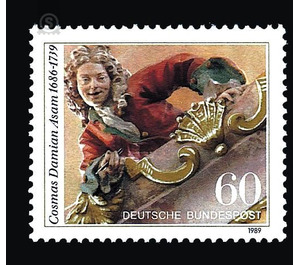250th anniversary of death of Cosmas Damian Asam - Germany / Federal Republic of Germany 1989 - 60 Pfennig
Theme: Calender
| Country | Germany / Federal Republic of Germany |
| Issue Date | 1989 |
| Face Value | 60.00 |
| Color | brown |
| Perforation | K 14 |
| Printing Type | 4-color offset printing and gold bronze |
| Stamp Type | Postage stamp |
| Item Type | Stamp |
| Chronological Issue Number | 1293 |
| Chronological Chapter | GER-BRD |
| SID | 178127 |
| In 45 Wishlists | |
When Cosmas Damian Asam died 250 years ago in Munich on May 10, 1739, the "pictor et architectus" left behind a rich and still fascinating work. In more than fifty different locations in southern Germany - but also in Switzerland, Bohemia and Silesia - he had played a decisive role in the construction and furnishing of mostly sacral large-scale buildings and had left his unmistakable mark on them as a master builder, frescoe or oil painter. Like no other German artist of that time, his works convey to the present day a vivid picture of an epoch that was as much influenced by a joyous display of splendor as it was by deep religiosity. The life of Cosmas Damian Asams, who was born on September 28, 1686 in Benediktbeuren, was determined from the beginning by the painter profession of his father Hans Georg Asam (1649 - 1711). In the manner of a traveling artist, the father traveled with his family to the places of his respective assignments. Through cooperation in his father's business Cosmas Damian received his first training, as well as his six years younger brother Egid Quirin Asam (1692 - 1750). While his brother worked as an apprentice to a Munich sculptor after the death of his father, Cosmas Damian went on to study in Rome, the then center of the European art scene. There he became acquainted with the masterpieces of the ceiling paintings of the Italian High and Late Baroque, an impression of lasting influence on his later work. The most important event of his stay in Rome in 1713 was winning a first prize in the competition of the Roman Painters Academy, which he received on 23 May in the presence of Pope Clement XI. was awarded. In the same year Asam probably returned to his homeland. Here there was an acute need for qualified equipment artists in order to be able to resume work on churches and monasteries which had been left behind because of the War of Spanish Succession (1701-1714). As early as 1714, Cosmas Damian signed the dome fresco in Ensdorf, the first in a long line of important orders. His professional consolidation reached its first peak with the order for the painting of the church of Weingarten (1718). In the frescos of this largest post-medieval church building in Germany, Asam developed for the first time his own kind of perfectly mastered illusionist ceiling painting, which he knew how to use to vividly illustrate the most complicated theological themes. The possibilities of this newly acquired "language ability" of the ceiling picture (B. Rupprecht) also shows the painting of the church of Aldersbach 1720/21. Both churches - Weingarten and Aldersbach - have become trend-setting for the further development of Southern German fresco painting, for Asam they were above all the precursor for his actual masterpiece of these years - the monastery church of Weltenburg (1721). Cosmas Damian realized here as the responsible master builder and painter, together with his brother, who carried out the sculptural works, the most important sacral Gesamtkunstwerk of the South German Baroque: a sovereign synthesis of architecture, decoration, painting and sculpture, the high quality only with the Wieskirche Dominikus Zimmermanns can be compared. Weltenburg had finally consolidated the artistic fame of the Asams. The following years were marked by numerous non-Bavarian large orders to the "family business". This economic success enabled the brothers in 1733 to undertake the construction and equipment of a personal votive church in Munich at their own expense. In the ceiling of this church, Cosmas Damian once again demonstrated the full pictorial power of his painterly illusionism. The completion of the "Asamkirche" to experience, this last joint work with the brother, however, the artist was no longer granted. (Text: cand. Phil. Stephan Klingen - Kunsthistorisches Institut der Universität Bonn)


